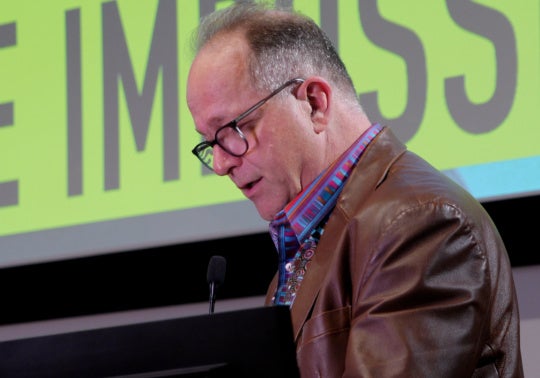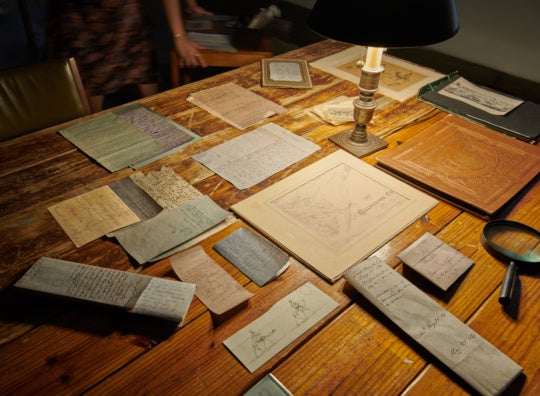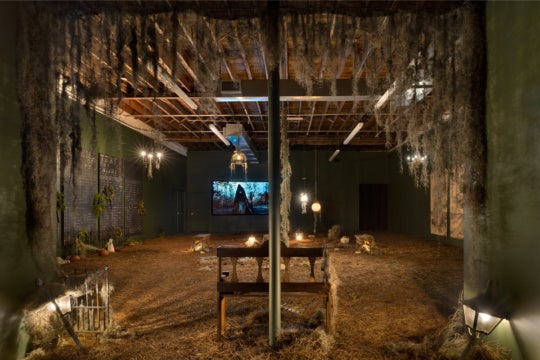
In Shadow Puppets: Traces of New Documentary Practices, curators Stephanie Dowda and Jill Frank present a collection of still and moving images that depict the see-saw between seeing and believing. These are moments when an individual’s visual perception creates friction between presence and the known but unseen. Each artist unearths photography’s indexical quality, exposing the often-convoluted distinction between presumption and visual evidence. Examining the processes of interpretation, the exhibition combines works that are exercises in unlearning and deprogramming visual cues.
In Guillermo Gudiño‘s Infinite Longing, the work’s physicality treads between picture and sculpture, here and beyond. As an investigation into the physical, optical, and metaphorical limits of the horizon, Infinite Longing articulates how an image can stand in for an event but never entirely reaches resolution.
Optically, the three-dimensional object presents the conundrum its title suggests. From a distance, Infinite Longing successfully channels the visual experience of that sliver of light we understand to be the horizon. From afar the image itself triggers whatever mental images and associations we have. The horizon, however, inevitably becomes more elusive on approach. Iterating a viewer’s visual cues because of the “natural” inclination to come close to an artwork, the action also performs the desire to attempt to reach the unattainable physical point.
As the physical distance between the viewer and the object shrinks, the elements of the construction become more apparent. The horizon is plainly constructed within a thin wooden frame by two sheets of styrene separated by a lit fluorescent tube. While the top sheet appears to be unaltered, the bottom is printed with an image of a vast barren landscape. Their difference reinforces the landscape as an object and not a window into space.

Through that approach, however, we learn that the photograph’s origin is actually Mars, taken by the rover roaming the planet. As such it is both a familiar yet foreign landscape, depicting a place that we can grasp conceptually but not physically, and one we cannot see with the naked eye but now have access to remotely.
These shifts in perspective are what W.J.T Mitchell calls “multistable” images. Like the Necker cube or the “the Duck-Rabbit,” Infinite Longing generates similar liminal or threshold-type experiences that say as much about the subjectivity of the observer as the picture itself.
Before the exhibition’s opening, I was able to sit down with the Gudiño and discuss the potential for exploring a physical phenomenon imbued with so many other meanings.
BURNAWAY: Let’s start from the beginning, where does the photo come from?
Guillermo Gudiño: The photo, as it says on the label—the source of the image is from NASA. It’s a photo of Mars. It’s from the Curiosity rover. It’s a new image from November.
BA: That just blew my mind. Because when you come to it, especially because it’s the first image you see when you walk into the exhibition, the first thing I tried to do was associate where I’ve seen this kind of landscape before. I’m from the West [so] I thought to myself, “I’ve seen this kind of image.” I’ve been reading James Turrell who writes about Nevada, and again, I thought, “I’ve seen this kind of image.” It is something that slowly unveils itself to you. From a distance—I didn’t read the label—you can imagine the vantage point of where the photographer is standing. So then to learn that it’s an image from Mars ….
GG: Nobody was standing there in this case. There were no [photographic] decisions in terms of framing even. That’s why I picked that one. These images that are taken from Mars come from a very small camera, just two megapixels. For example, this image is actually 90 or 100 photos. They send them from mars to here, one by one, and here they stitch them together. So it’s this panorama with a weird shape that, if you put them together as a rectangle, it will have these strange black shapes where it wasn’t filled in completely. And from this bigger image, I decided which fragments to use for the piece. It’s same thing you do when you have a continuous image that you photograph. You fragment and select it, and that’s what you use. If I had the chance to go there, this is the image that I would have taken. So if they are giving me the option to choose from this amazing, almost complete panorama, then I am also questioning the authorship or the property of the image at the same time.
BA: One of the things it starts to trouble is the idea of the photographer capturing an event, capturing a place because you are really constructing how the horizon is being re-presented, and it’s not necessarily to recreate it an authentic way. Because who knows what it would feel like up there? It could be completely warped.
GG: Exactly, they are all ideas in the end. And that’s part of what I’m trying to say here. Even your experience of a place like that would be an idea of the experience of the place. I am just proposing a materialization of my idea on what a horizon is, and what a horizon in Mars could be. So it’s like your idea against my idea, and the scene out there would still be that. So they are all constructions, all projections. What I am doing here is just showing how I am trying to shape the idea. It is somewhere between the idea and the fact because it’s material … containing elements that you would see in a restaurant.
BA: Do you think these images of Mars that we are seeing for the first time are getting us closer or farther from the idea of Mars?
GG: In some ways it just makes me feel more conscious of how that place changes with the different inputs I receive. I don’t know where my previous ideas of Mars came from—was it my idea or from someone else?—or whether I got it from books or other pictures. So as more pieces of information reshape my idea, they make me aware of how my ideas of this place are continuously changing, and I have no way of verifying whether my idea is closer or farther from being correct or true.
For me that’s very interesting because that also happens here, even with your bedroom or with very familiar places. But we tend to think of them as fixed, as if they have a solid foundation that allows you to verify facts, or that they have to stay stable. I think this is where I get a lot of my motivation to work with these kinds of images. Since the reference is so loose and so far away from us, it has a lot of potential to work with the relationship between the actual place and the representation of the place—trying to mix it and test the flexibility of the connection between the two.

BA: What strikes me about this work is how transparent it is. You see the frame. You see the rock that props it up. At what point did working with a concept of a horizon make you want to create an installation?
GG: I don’t know if it was as conscious as that—switching between an image and installation. My thinking about photography for a while has become much more material and objective. And this comes from my reading and theory—I started consider any image as an object. For example, they all have a width even if it’s on an iPod. One thing that fascinates me about photography is how much people buy what the photograph is trying to sell—so much so that you don’t see the photograph anymore you just see what it is trying to propose. So in many of my projects, I try to think about how we can look at a photograph and the object at the same time to become more aware of how we look.
BA: Do you find that working through an idea like the horizon is formal? Is it about perception, or does it go deeper in terms of why it has struck a chord with you?
GG: In many different ways, I started reading in terms of philosophy what a horizon means, or what it can represent. From a psychological point of view, what does it mean when we say casually “expand your horizon.” Or also from a physical point of view, what does it mean that, from here right now we can point to where the horizon is, and how do we feel bounded from that? But I also started reading scientific explanations that talked about how the horizon works. I am trying to get closer to the idea without constraining the possibilities of where it takes me.
BA: The landscape in general has been able to visualize the unknown, powerful, and overwhelming. As I think about your work, I think about how it taps into the unknown and how it feels like it’s getting closer, in a way that is specific to outer space, but also intimate.
GG: The unknown is always going to be there. Even if we get to Mars there will still be a horizon. So what does it mean? Even though there is the temptation, we can’t get to the horizon even if we try. It’s just going to go farther away. It’s going to remain. Even if we try to know everything, because that’s what we think we do the best …. If we know it, then we can control it, as if you could get rid of the unknown. Like trying to reach the horizon—it’s as simple as that. The work is like a reminder that the unknown is always present in our lives, so where do you position yourself?




